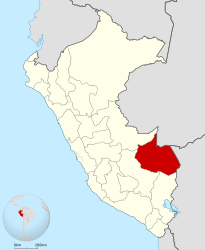Madre de Dios region
| Madre de Dios region | |||
|---|---|---|---|
| Symbols | |||
|
|||
| Basic data | |||
| Country | Peru | ||
| Capital | Puerto Maldonado | ||
| surface | 85,183 km² | ||
| Residents | 137,300 (2015) | ||
| density | 1.6 inhabitants per km² | ||
| ISO 3166-2 | PE-MDD | ||
| Website | regionmadrededios.gob.pe/new/ (Spanish) | ||
| politics | |||
| Gobernador regional | Luis Hidalgo Okimura (2019-2022) | ||
| Provinces of the Madre de Dios region | |||
Coordinates: 12 ° 32 ′ S , 69 ° 29 ′ W
The region Madre de Dios [ ˈmaðɾe ðe ðjos ] (Spanish Región Madre de Dios , Quechua Diyuspa Mama suyu , in English "Mother of God") is a region in southeastern Peru , on the border with Brazil and Bolivia . It covers 85,183 square kilometers with only 137,300 inhabitants (2015). Almost three quarters of them live in the capital Puerto Maldonado , which is around 400 km east of Cusco . The region lies on the southwestern edge of the Amazon basin - it is the southernmost region in the Peruvian Amazon.
Named the region after the eponymous river , which on the east side of the Andes rises, but then not like the Peruvian headwaters of the Amazon River , flows north, but to the east, across the far north of Bolivia, where he in the Beni River empties , which then forms the Rio Madeira with the Río Mamoré in Brazil , the first large Amazon tributary below the junction of the Solimões and Rio Negro .
geography
Almost the entire area of the region is covered by tropical rainforest , which is famous for its biodiversity. The Manu National Park and the Tambopata-Candamo protected area were established in 1990 to preserve them . Madre de Dios lives mainly from tourism , as well as from the cultivation of rubber , gold panning and logging . Larger rivers in the region are the Río Madre de Dios with a length of 1150 km , of which 667 km are in Peru and 483 km in Bolivia, and the 900 km long Río Tahuamanu with 450 km each in Peru and Bolivia.
see also: Lago Sandoval
Provinces
The region is divided into three provinces and these in turn into 11 districts:
| province | Capital |
|---|---|
| Manu | Salvación |
| Tahuamanu | Iñapari |
| Tambopata | Puerto Maldonado |




